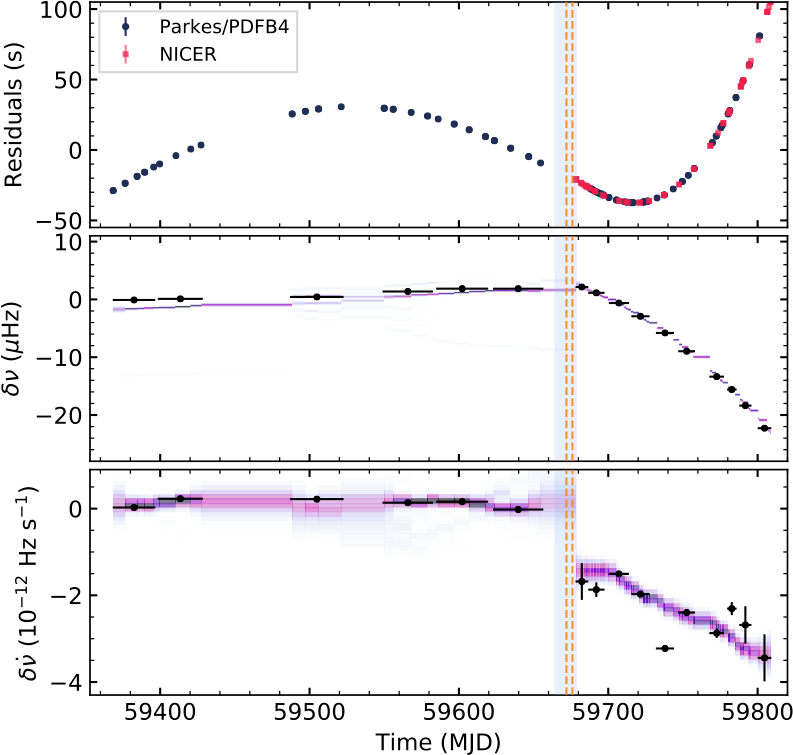NICER / ISS Science Nugget
for February 23, 2023
Radio Silence from a Magnetar During an X-ray Outburst
Magnetars constitute the most extreme population within the zoo of isolated neutron stars. They possess the strongest measured magnetic fields in the universe, upward of 10^14 Gauss (10^10 Tesla). They are observed as bright X-ray sources and, at times, as radio pulsars. Magnetars are also unique in their variability, exhibiting millisecond-duration X-ray and radio bursts, as well as enhanced X-ray and radio emission during years-long outbursts. All of these attributes are driven by the gradual decay of their immense magnetic fields, stressing the stellar surface beyond its yield limit and twisting the external magnetic field lines, forming loops akin to those observed on the Sun.
On 2022 April 7, the NICER team was alerted to an X-ray burst detected by NASA's Swift observatory from the magnetar 1E 1547.0-5408. NICER observations within 48 hours revealed that its brightness had increased by a factor of 4 above the known persistent level, indicating that 1E 1547.0 was undergoing a high-energy outburst, its first since 2009. Knowing that this magnetar is capable of emitting radio pulsations, NICER contacted colleagues in South Africa and Australia who monitor it regularly with Murriyang, the 64-m Parkes radio telescope. Interestingly, 1E 1547.0, a persistent radio source for about a decade, had been radio-quiet in two observations spanning 3 weeks preceding the detection of the outburst. Two weeks after the initial NICER observation, the soft X-ray flux returned to its pre-outburst level and the radio emission engine resumed. The two teams joined forces to characterize this high-energy outburst from 1E 1547.0 and its radio disappearing act (Lower et al. 2023, accepted this week for peer-reviewed publication in The Astrophysical Journal). Apart from the radio and soft X-ray flux variation, the source also exhibited a large jump in its regular spin-down coincident with the outburst onset (a phenomenon known as a "glitch"), as well as changes to the shape of its soft X-ray pulse profile, which tracks the surface emission pattern as a function of the star's rotation. An observation obtained by NASA's NuSTAR telescope during the outburst revealed, however, no variation in the emission pattern at higher (> 10 keV) X-ray energies.
The combined radio/X-ray results are consistent with expectations for localized stresses on the magnetar surface, particularly in quasi-polar regions from which the magnetospheric radio emission is thought to emanate. Such stresses may lead to a changing twist in the magnetic field lines accompanied by broader heating of the surface, a brief quenching of the radio signal, and higher torque on the star. Emission above 10 keV may remain unaffected because it is thought to emerge from the more stable, closed dipole magnetic-field zone. These results highlight the power of multi-wavelength monitoring of magnetars in deciphering their dynamical evolution.


Figure:
Left, upper panel: The X-ray 0.5-10 keV energy band (NICER data in red and Swift X-Ray Telescope in black). Lower panel: Radio flux (Parkes, Australia) of magnetar 1E 1547.0-5408 from 2022 January to August. The vertical dashed lines indicate the dates of short bursts detected by instruments onboard NASA's Fermi (April 3) and Swift (April 7) observatories. The blue shaded region corresponds to the interval over which pulsed radio emission was not detected. Gray horizontal shading corresponds to one standard deviation around the baseline X-ray flux. Figure from Lower et al. (2023).
Right, upper panel: Timing residuals from radio and NICER X-ray observations (observed minus predicted pulse arrival times; top panel) of 1E 1547.0 from 2021 June to 2022 August. Changes in the magnetar spin frequency and spin-down rate with respect to their nominal values (0.4788 Hz and -3.63e-12 Hz/s at MJD 59635 = 2022-02-25) are shown in the middle and bottom panels, respectively. Note the large jump in spin-down coincident with the outburst, implying a sudden increase in torque on the star. Figure from Lower et al. (2023).
<< Previous
Main Index
Next >>